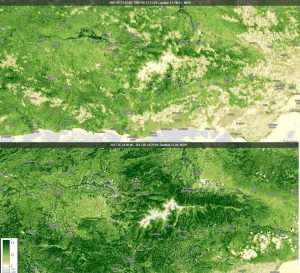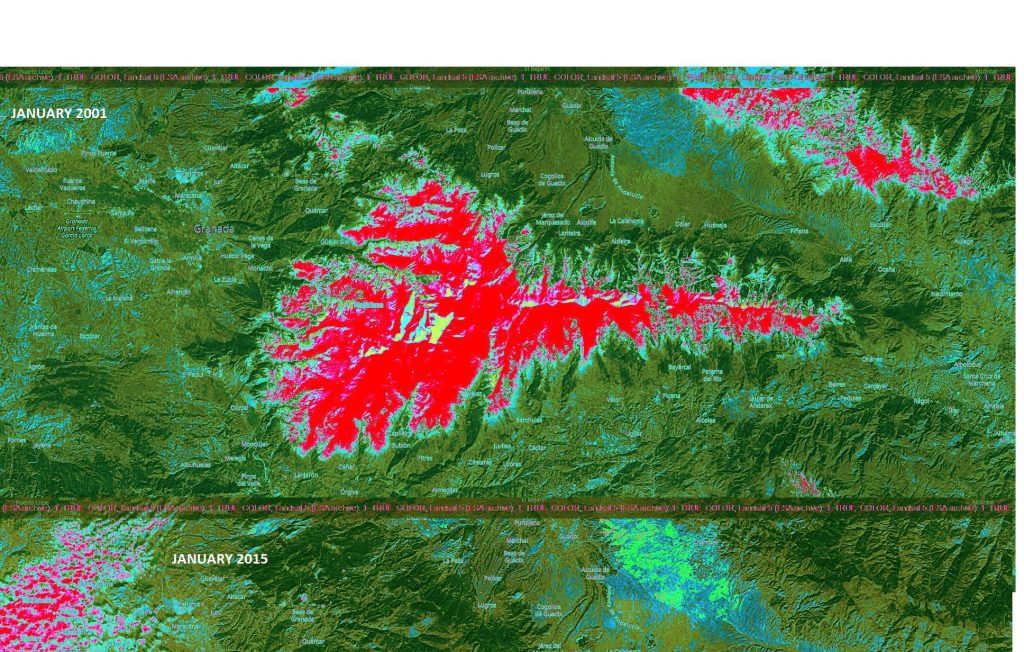Climate Detectives Projects 2022-2023
Project title: “SIERRA NEVADA: Economic and Ecological Evolution”
Team: 4º ESO CC IESPM
IES Padre Manjón Granada Spain 20 Student’s age: 14-15 years old, 16-17 years old
To what extent is climate change and other anthropogenic actions affecting the endemic species of Sierra Nevada and the performance of the ski resort?

Our group of students wanted to investigate how climate change is affecting the ecosystems of Sierra Nevada, which is home to many endemic species. We are concerned about the potential threat to the ski resort, which is a major economic driver in the area. Some of us also studied the impact of human activities on the various ecosystems of the Natural Park, especially in the high mountain areas where the main endemics are found.
We used satellite images from EO Browser to check for evidence of climate change, including changes in water levels during the summer months, changes in snow cover during winter months, and changes in vegetation cover, which depends on humidity and affects the survival and changes of endemic plants. We also analyzed different climate databases, primarily temperature and precipitation, to cover a wider time range. Lastly, we researched various sources online to gather data on the main endemic animal and plant species, their location, and protection measures that have been applied throughout history in the park.
Our goal was to make new proposals to help protect these species and ecosystems. We also studied the economic performance of the ski resort and its impact on the park’s ecosystems to evaluate its sustainability. Finally, we looked at other human impacts, such as infrastructure, agricultural and livestock activities, and tourism, that could be putting some endemic species at risk of extinction.

The data obtained from satellite imagery and secondary sources clearly shows that climate change is affecting the climate of Sierra Nevada, causing the temperature to rise by about two degrees Celsius and precipitation to decrease. This is also affecting the vegetation cover, as we have confirmed with satellite images, and is one of the main reasons why numerous endemic species are at risk of extinction.
It is likely that ski seasons and skiable surfaces will be reduced, endangering the economic activity of the ski resort. However, we consider the ski resort to be a sustainable activity as long as it occupies only a small part of the park, protecting the rest.
We have also found other impacts in the area, such as the abandonment of agriculture in mid-mountain areas, which could accelerate desertification, and dangerous livestock activity, which, coupled with the reduction of high mountain areas, could increase threats to native flora and fauna.

We recommend generating taxes for private activities and using a percentage of public profits to invest in reversing the impacts of the ski resort. To address climate change, we suggest disseminating studies that demonstrate ecological and economic consequences to promote responsible behavior. Additionally, we suggest implementing energy-saving measures in the park, such as renewable energy in hotels, promoting public and electric transportation, using low-consumption appliances, etc. We also recommend controlling livestock activities in high mountain areas, promoting eco-tourism, limiting access to sensitive areas, increasing penalties for littering or activities that pose a fire risk, and providing aid to restore abandoned agricultural fields while promoting sustainable agricultural techniques and a circular economy as a tourist attraction.
https://sites.google.com/iespm.es/sierranevadaclimateiespm/inicio
Projects are created by the teams and they take the full responsibility of the shared data.
← All projects





